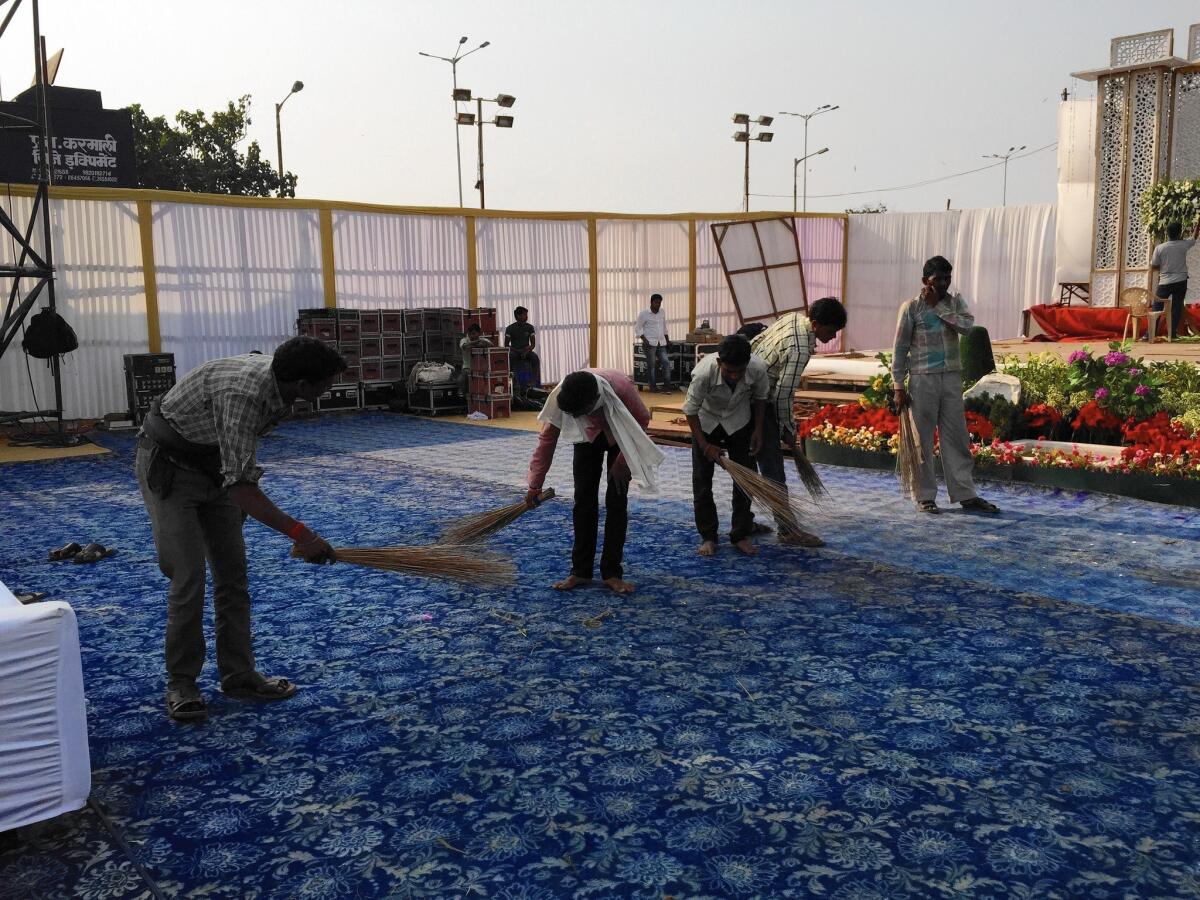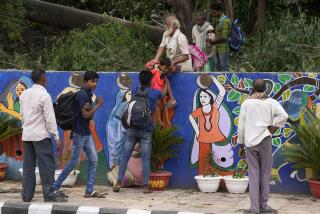In Mumbai, club weddings call for grand receptions

- Share via
Reporting from MUMBAI, India — It’s winter in Mumbai, which means the Queen’s Necklace, the nickname for the sea-hugging boulevard whose street lamps evoke a string of pearls, is lighted more gaudily than usual.
Along a half-mile stretch of the thoroughfare sits a succession of private clubs known as gymkhanas, where generations of families have whiled away the evenings smacking cricket balls, sipping tea and, in the cooler months, attending weddings on the expansive lawns.
These days, when the sun dips over the Arabian Sea, the gymkhanas are lighted up like carnivals as the prosperous families of this commercial city throw ever more lavish wedding receptions. Traffic slows to a crawl as cars dislodge guests in their finery and people gaze upon the decor, custom-built for each event by armies of designers, florists, carpenters and electricians.
On a recent, cloudless evening, almost every gymkhana appeared to be hosting a wedding with a different motif, judging from the elaborately constructed entrances along the road.
One featured faux white colonnades wreathed in flowers, with fairy lights swaying from the trees. Another, Islam Gymkhana, had massive wooden panels carved in intricate patterns, suggesting a sultan’s palace.
They must appear, to the street vendors and taxi drivers who ply the boulevard, like a succession of VIP tents to which they would rarely have access.
A few hours earlier, under an unseasonably hot sun, workmen in tank tops and slippers bustled about the Islam Gymkhana grounds, setting up sofas and chairs on an area the size of a couple of football fields. The coordinator, Abbas, a tall man with a bushy beard and all-business manner, said he was preparing to accommodate a reception for 7,000 guests.
Islam Gymkhana, as its name suggests, is predominantly Muslim, but it welcomes non-Muslims as well. To get the place ready, hundreds of men had worked around the clock for three days. Abbas did not divulge the identity of the newlywed couple, whose marriage had taken place at a separate location; one of the caterers said he heard only that one of the fathers owned a business.
Emerging from behind a wall of fake flowers, carpenter Vishwanath Sharma, 32, said he had worked a triple shift the day before. He arrived at 10 a.m. and worked until 4 in the morning, when he could catch the first train of the day. He rode home and slept for a few hours before returning to the grounds for another morning shift.
“This is the busiest time of year,” said Sharma, a father of three. Sweat glazed his shoulders, which were bare beneath a sleeveless athletic shirt. Wiping his brow, he said he can earn about $16 a day during wedding season, much more than in the off-season, when he gets only basic repair jobs.
Having worked several years on Bollywood film sets, Sharma was accustomed to spectacle. He was unimpressed by the acres of carpeting that had been rolled out over the green lawns or the mountains of stainless steel vessels stacked in a corner, ready to be arrayed across a buffet spread the size of a hotel ballroom.
And that was just the dining area for vegetarians. On the other side of the grounds was a similarly sized spread that would serve meat dishes.
“People are spending more and more on weddings,” Sharma said. “There’s 100 people just building the stage.” Behind him, at the north end of the grounds, workmen on a long podium were fastening large bouquets of flowers to a backdrop of arabesque patterns.
Nearby, Nilesh Naik, a rail-thin man in his 20s with dreadlocks and multiple ear piercings, emptied his backpack onto a catering table. A dozen walkie-talkies tumbled out. Naik said they were for the security guards and catering supervisors.
“It’s normal for weddings to have these now,” said Naik, who also runs a DJ business. But as he glanced around, he acknowledged, “This is a pretty big wedding.”
It’s not uncommon for upper-crust Indian families to spend hundreds of thousands of dollars on a wedding. This one, workers said, was comparatively modest, with its selection of artificial flowers and a midrange caterer known for biryani, a comfort food.
Ram Kumar Singh, a waiter, sat on a plastic crate playing with his cellphone. A few days earlier, he had worked a wedding with more than 15,000 guests in Rajkot, in western India. The previous night, he was at a smaller wedding in northern Mumbai; the night after this, he was due at a reception in one of the fast-growing suburbs.
Singh, 20, works for an ice cream company whose specialty is a dessert modeled on the dosa, a savory crepe from southern India. Thousands of the dessert dosas were waiting in freezers, he said. As he waited for them to be unloaded, he pondered whether he would ever want a wedding this size.
“No,” he said at last. “Something much more low-key.”
More to Read
Sign up for Essential California
The most important California stories and recommendations in your inbox every morning.
You may occasionally receive promotional content from the Los Angeles Times.











